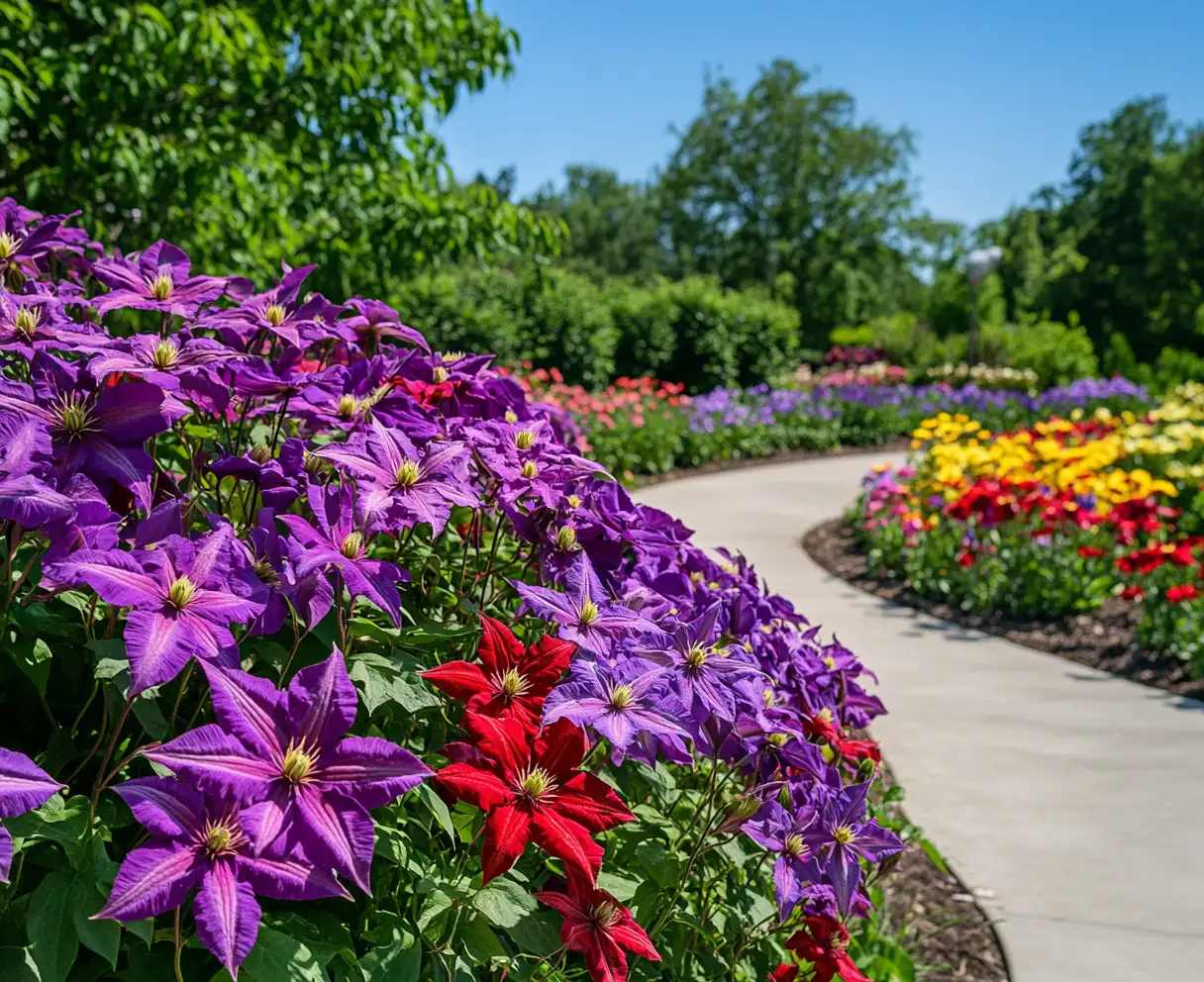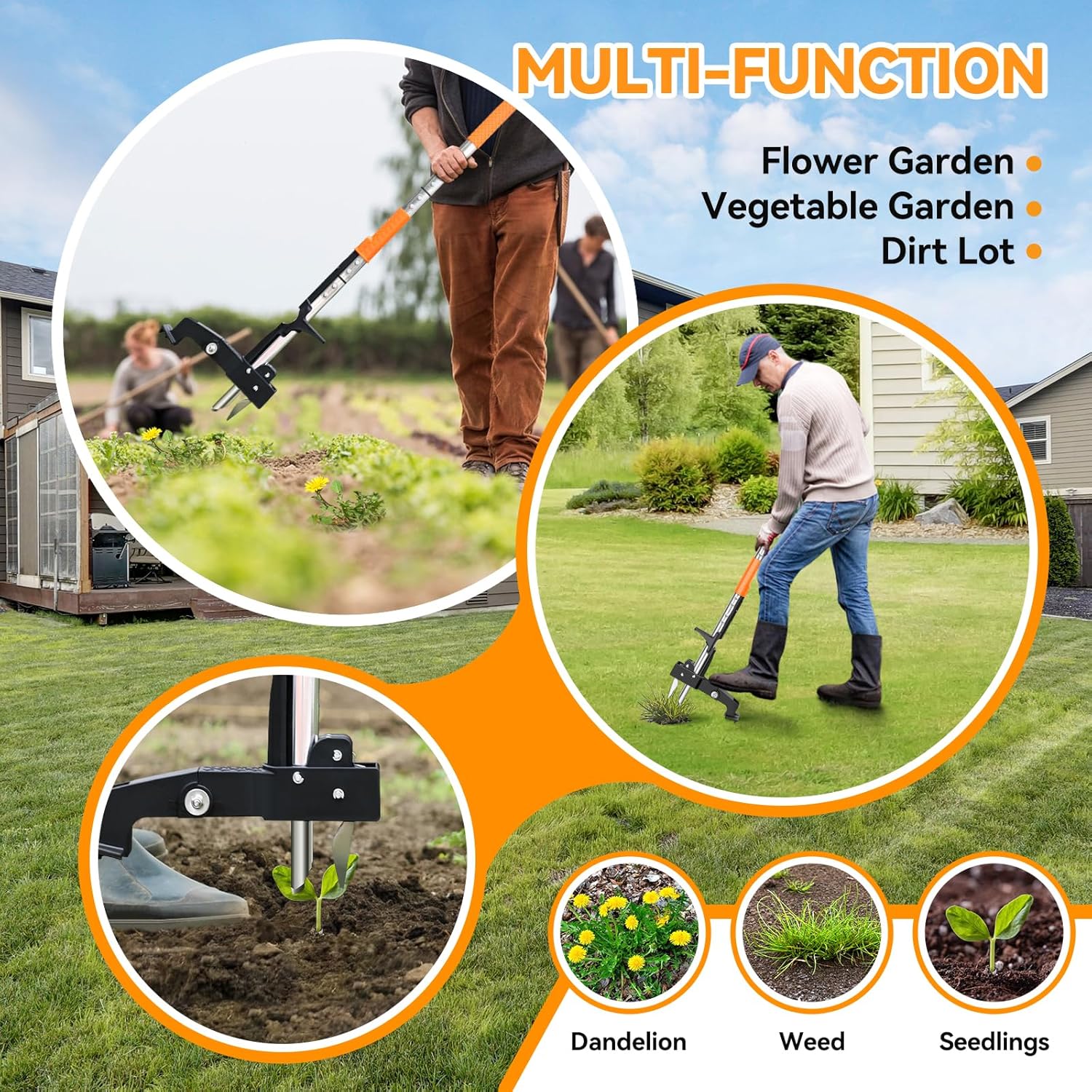Growing clematis vines is a deeply rewarding endeavor that can transform any garden with elegant, colorful blooms and graceful vertical appeal. Whether cascading over a trellis, climbing an arbor, or spilling from a container, clematis offers a stunning focal point for any space. For inspiration on vertical structures, check out these DIY garden trellis ideas that pair beautifully with clematis.
These perennial vines bring more than just beauty—they’re also wonderfully low-maintenance once established. Available in a diverse palette of colors, shapes, and sizes, clematis vines are beloved by both new and seasoned gardeners. Want more floral variety? Explore other perennials that thrive in full sun for extended seasonal interest.
Clematis is perfect for adding height and charm, softening fences or blank walls, and directing the eye upward in your landscape. For even more design tips, browse clematis trellis ideas and learn how to integrate this classic vine into your garden’s layout with style and structure.
Table of Contents
🌿 Important Considerations Before You Buy
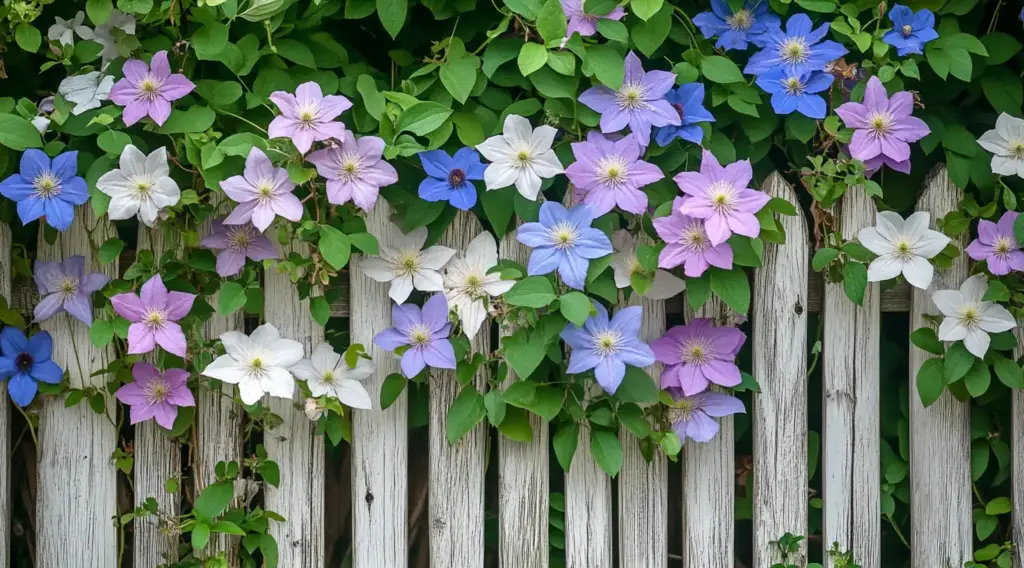
Before diving into growing clematis vines, it’s crucial to choose the right variety that fits both your garden space and your aesthetic goals. Not all clematis are created equal—some are bold climbers, while others behave more like tidy, blooming shrubs.
✅ Know the Growth Habit
Clematis varieties fall into two main categories:
- Vigorous climbers: These types are best for covering fences, walls, or trellises quickly. Fast-growers like Jackmanii or Sweet Autumn Clematis can shoot up several feet each season.
- Compact or bush-types: Ideal for containers, borders, or small-space gardens, these clematis maintain a more manageable size and often require less pruning or support.
When growing clematis vines, matching the plant’s growth habit to your garden setup helps avoid disappointment and overgrowth.
✅ Match to Your Garden’s Purpose
Think about your goal:
- Want to soften a tall fence? Go with a fast-growing vine.
- Need a colorful edge to a flower bed? Choose a bush or compact variety.
- Want long bloom seasons? Opt for repeat bloomers or those in Group 2 for pruning (more on this later).
⚠️ Pet Safety Reminder
While beautiful, some clematis varieties can be mildly toxic to pets, especially dogs and cats. If your furry friends have a habit of nibbling on plants, do your homework. Research your chosen variety or consult a vet before planting.
🌞 Sunlight Needs
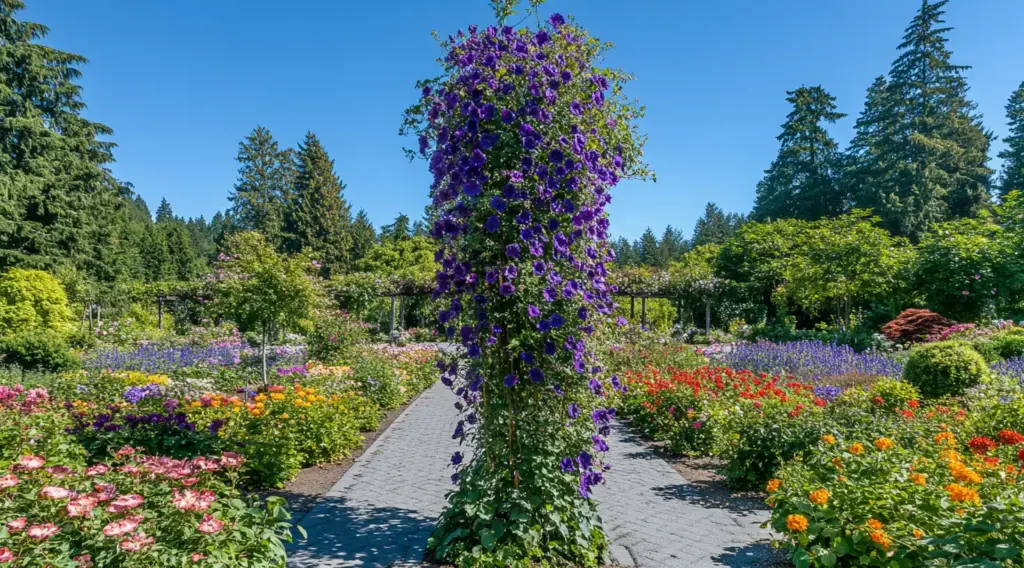
Sun exposure plays a key role in successfully growing clematis vines. While many varieties are sun lovers, not all require intense, all-day rays. The secret lies in a tried-and-true gardener’s mantra: “Head in the sun, feet in the shade.”
☀️ How Much Sun Do Clematis Vines Need?
- Full sun (6+ hours/day) is ideal for most flowering varieties to maximize blooms.
- Partial sun (4–6 hours/day) is acceptable for certain types, especially in hot climates where too much intense sun may scorch leaves.
When planning your planting site, aim for morning sun and afternoon shade if possible. This balance encourages strong flower production while preventing heat stress.
🌱 Keep Roots Cool and Moist
Even sun-loving clematis vines prefer cool, shaded roots. Here are a few gardener-approved tricks to achieve that:
- Mulch generously at the base to retain moisture and regulate soil temperature.
- Plant low-growing perennials or ground covers around the base. Think hostas, thyme, or creeping Jenny—these “living root umbrellas” are both functional and attractive.
- Avoid shallow watering. Deep, infrequent watering is better for root development.
Shading the root zone while providing sunlight to the foliage helps keep your plant blooming vigorously while staying stress-free.
🏗 Choosing & Installing Support

Support is critical when growing clematis vines, especially for climbing varieties. A well-chosen structure not only helps your plant thrive but also adds beauty and vertical interest to your garden design.
🪜 Install Supports Before You Plant
The golden rule? Set up your support system before planting. Installing structures afterward can disturb fragile roots and risk damaging the plant.
🔧 Types of Clematis-Friendly Supports
Clematis vines aren’t aggressive climbers like some other vines—they need a little help. They climb by twining their leaf stems around thin objects, so bulky supports don’t work well. Opt for these:
- Arbors – Create dramatic garden entrances or focal points.
- Trellises – Attach to walls or fences to soften harsh surfaces.
- Obelisks and Garden Towers – Add vertical charm to flower beds or containers.
- Wire Fencing or Mesh – Inexpensive and effective, especially along garden edges or raised beds.
Pro Tip: Clematis needs something thin to wrap around—shoot for support widths under ½ inch for the best grip.
🤝 Help It Cling (If Needed)
Not all clematis varieties naturally latch on. For those that don’t:
- Use soft garden ties, plant clips, or stretchy twine.
- Tie vines loosely to avoid constricting growth or damaging tender stems.
- Direct new shoots manually until the plant establishes a climbing pattern.
Early guidance leads to a neater, fuller display that covers your structure beautifully over time.
🪴 Using Bush-Type or Compact Clematis
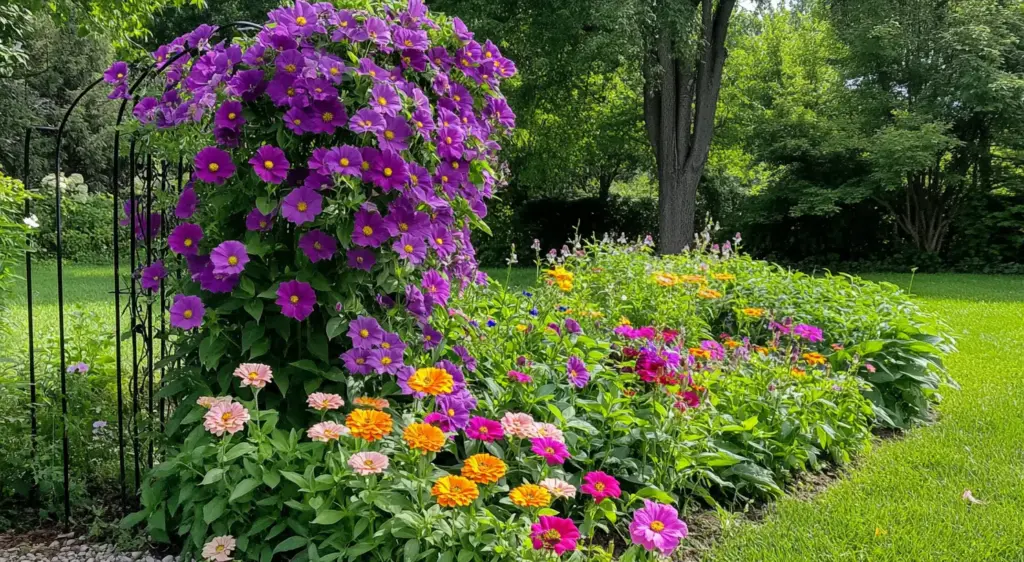
Not all clematis are towering climbers. If you’re gardening in a smaller space, working with containers, or simply want a splash of color at a lower level, growing clematis vines in bush or compact forms is a smart—and stunning—option.
🌼 Why Choose Compact Varieties?
Bush-type clematis are naturally shorter and more restrained in their growth habits. They’re perfect for:
- Containers on patios or balconies
- Garden borders and foundation plantings
- Filling gaps between taller plants
- Edging flower beds with cascading color
These varieties often have a mounding or semi-trailing form, meaning they can spill over edges or intermingle with other perennials, adding dynamic texture to your landscape.
🪴 Tips for Container Success
Want to grow clematis in a pot? Follow these guidelines:
- Use a deep container (at least 18 inches) to accommodate the root system.
- Provide a small trellis, obelisk, or stake if the plant needs light support.
- Ensure excellent drainage—clematis dislikes soggy roots.
- Feed regularly with a balanced liquid fertilizer during the growing season.
- Keep the roots shaded (use mulch or underplanting, even in containers).
Compact clematis varieties give you all the beauty of their climbing cousins in a more manageable, versatile form—ideal for tight spaces or decorative displays.
🛠️ How to Plant Clematis Vines: Step-by-Step

Planting clematis correctly sets the stage for long-term success. These vines are hardy and resilient, but a little care during planting goes a long way toward establishing healthy roots and abundant blooms.
🏗 Step 1: Dig a Wide Hole
Dig a hole twice the width of the nursery pot and slightly deeper. A wider hole encourages root spread, which supports a stronger, more stable plant.
🌿 Step 2: Improve the Soil
Mix in compost or well-aged organic matter with your native soil. Clematis prefer rich, well-draining soil with plenty of nutrients. If your garden has heavy clay or sandy soil, improving texture is essential.
💧 Step 3: Water the Hole (If Dry)
If the soil is dry, fill the hole with water and let it soak in. This primes the area so roots settle in easily and absorb moisture immediately.
🪴 Step 4: Gently Remove the Plant
Support the base of the plant and tip the pot upside down. Avoid yanking from the top, as clematis stems are fragile and prone to snapping.
🌱 Step 5: Loosen the Root Ball
Tease apart the outer roots gently. This encourages the roots to grow outward into the surrounding soil, rather than circling inward.
📏 Step 6: Set Proper Planting Depth
Most clematis vines should be planted at the same level as they were in the nursery pot, or 1–2 inches deeper. Slightly deeper planting can encourage new shoot growth from buried nodes.
⛏ Step 7: Backfill and Firm the Soil
Use your enriched soil mix to fill in the hole, gently firming it down to eliminate air pockets. Don’t compress too tightly—roots need oxygen to breathe.
💦 Step 8: Water Thoroughly
Give the newly planted clematis a deep soak to help the soil settle and hydrate the roots. Continue to water regularly during the first growing season until it’s well established.
Proper planting is the foundation of healthy clematis vines. With the right soil, depth, and moisture, your plant will reward you with beautiful, climbing blooms for years to come.
📐 Structural Tips for Training Clematis
Even after planting, growing clematis vines successfully involves some gentle guidance. These vines are not aggressive climbers and benefit from support as they develop—especially during their first year.
🪢 Handle with Care
Clematis stems may look lush, but they’re delicate and brittle, especially when young. Avoid rough handling or forceful tying. If a stem snaps, don’t panic—the plant will recover. Simply trim the break cleanly, and new shoots will emerge in time.
🌱 Train Weekly
Don’t wait until things get tangled. Instead:
- Check in weekly to guide new growth
- Wrap stems loosely around the support structure if they’re not naturally clinging
- Use soft ties or garden clips to fasten vines without strangling them
Regular training helps direct the vine’s path and encourages even coverage across your arbor, trellis, or fence.
🧭 Redirect Growth as Needed
Sometimes a stem will go rogue or grow in an unwanted direction. Just gently unwind it and guide it elsewhere. Clematis are forgiving and adaptable if you catch them early.
⏱ Patience Pays Off
In its first year, clematis often focuses on establishing roots rather than blooming. By year two or three, you’ll see a dramatic increase in flowering. Stick with your training routine early on—it pays dividends later.
❓ Frequently Asked Questions (FAQs)
Whether you’re a first-timer or seasoned gardener, questions often arise when growing clematis vines. Here are answers to some of the most common ones.
🗓️ When is the best time to plant clematis vines?
Early spring or fall is ideal—preferably on a cool, overcast morning. This minimizes transplant shock and gives the plant time to establish before extreme temperatures arrive.
☀️ Do clematis vines need full sun?
Yes, most varieties prefer full sun (at least 6 hours a day) for optimal blooming. However, many will tolerate partial sun. Always remember:
“Head in the sun, feet in the shade.”
Shade the root zone with mulch or low plants to keep it cool and moist.
🧾 Conclusion
Growing clematis vines is truly one of the most rewarding ways to add vertical elegance and vibrant, long-lasting blooms to your garden. With thoughtful planning, the right support structure, and proper attention to planting depth and sun exposure, clematis can thrive with minimal effort. If you’re new to perennial gardening, our guide on Perennials Made Easy offers more tips to get started with confidence.
Whether you’re training clematis up an arbor, letting them spill from containers, or weaving them through a mixed border, these vines bring unmatched versatility and charm. Need ideas for pairing clematis with other sun-loving plants? Browse through our curated list of full-sun perennials that make stunning garden companions.
As reliable perennials, clematis vines return each year—bigger, fuller, and even more breathtaking. So if you’re ready to elevate your outdoor space with seasonal color and structure, start growing clematis vines today. Your garden will thank you.
🚀 How fast do clematis vines grow?
Growth rate varies. Fast-growing varieties like Jackmanii or Sweet Autumn Clematis can reach full height quickly, while others take a few years to mature. Good support, sunlight, and soil all speed things up.
🪜 How do I support clematis vines while they grow?
Install a trellis, arbor, or mesh fencing before planting. Use soft ties or clips for varieties that don’t self-cling. Check the plant’s habit to determine its needs.
🪴 Can I grow clematis in containers?
Absolutely! Many compact varieties thrive in deep containers with proper drainage. Use a rich potting mix and small trellis for support. Keep them watered and feed during the growing season.
🌸 Why aren’t my clematis blooming?
Several reasons could be to blame:
- Not enough sun
- Wrong pruning technique (especially if the pruning group is unknown)
- Lack of nutrients
- Immature plant (most bloom best in their second or third year)
Identify your variety and follow care guidelines accordingly.
🐾 Are clematis vines toxic to pets?
Yes, some varieties can be mildly toxic to dogs and cats. Symptoms may include drooling, vomiting, or diarrhea if ingested. If you have curious pets, choose your clematis carefully and plant it in less accessible areas.

